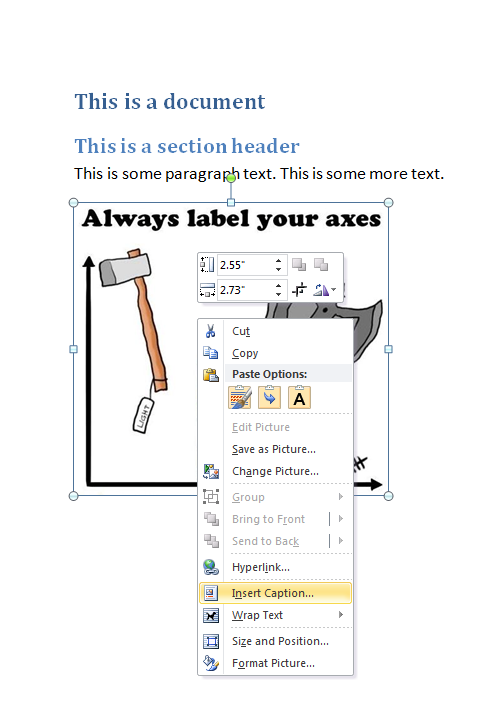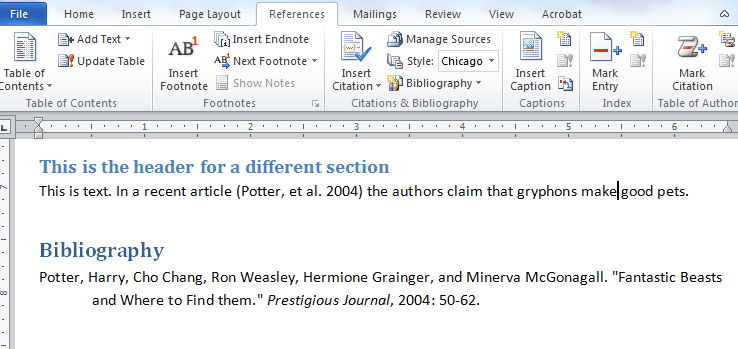Word has a lot of features that can help make your report-writing go better. Here are some that you should definitely use. The screencaps here were taken using Word 2010. Later versions of Word look different but have the same functions.
Adding captions to figures
Word will automatically add a caption to a figure if you right-click on the figure and select “Insert Caption”. (Same for tables.) All figures and tables should have captions, and using Word’s built-in captioning is the right way to generate them, because then the caption number becomes a field that will (in theory) be automatically updated as appropriate. (As always, with things that are supposed to be automated, it pays to be slightly paranoid: do check that all the numbers make sense before printing!)
Referring to captions in the text
Once you’ve added a caption, you can use the cross-reference feature (under the References tab) to insert another automatically-updated field making reference to the caption, into the body of the text. You can insert references to different kinds of fields, and can choose whether to quote the whole caption or just the item and number.
Using pre-defined styles
Word’s default template has a number of built-in “styles” defined: Normal text, Heading 1,2,3… These headers and sub-headers are useful visually–they help to make the organization of the ideas clear–and they’re also useful for navigation. If you enable the Navigation Pane, a sidebar will show you a table of contents that’s automatically generated from the first three heading styles (by default–you can change how many levels are included).
Word will also generate a table of contents from headers (go to References>Table of Contents to see a bunch of options). The table of contents is one big field, and you should remember to update it before you print so that the page numbering is accurate.
Citations
Word has a decent built-in citation manager. In References > Manage Sources, you can add the relevant information for new references (journal articles, books…). Use Insert Citation to refer to one of your sources in your text. Use Bibliography to add a list of sources at the end of your document. Generally it’s better to use in-line citations and a bibliography at the end than footnotes.
If you want your references to be stored online, or if you want to be able to gather references automatically instead of entering information by hand, you might consider using RefWorks instead of Word’s citation manager. The Write-n-Cite plug-in lets you add citations to Word. There are other citation managers; you can choose whichever you prefer. (For example, using the BibTex format will make it easy to use the same references to create bibliographies in either Word or R Markdown.)
Page Layout
- Page breaks are great because they let you make sure that material doesn’t end up spread awkwardly across pages–keeping a table all on the same page, for example. Use page breaks, and not multiple carriage returns.
- Sometimes it’s necessary to put one page in landscape orientation, even though the rest of the document is in portrait orientation. Do that by inserting two “next page” section breaks, then changing the orientation of the one page in between the breaks.
- For reports with more than one page, headers and footers can be really useful. It’s good practice to have the document title, the date (for the sake of version control), and the page number appear on every page.
Review
- When using Spelling & Grammar, it’s best to set the proofing language to “English (Canada)”–some Canadian spellings are slightly different from the U.S. versions.
- Comments can be handy for discussing revisions in progress, or as notes to yourself about things you still need to change.
- The Track Changes setting is handy for shared revisions. Just make sure to hit the “Accept all changes in document” button before printing, to get rid of mark-up text.
- The Compare feature lets you see the differences between versions of a document: handy if you can’t remember all the steps in a revision process!


